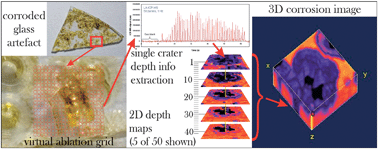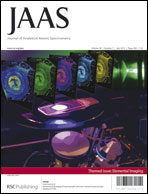In this work, a multi-elemental 3D laser ablation-ICP-mass spectrometry mapping procedure for high-resolution depth information retrieval to investigate surface layer phenomena is presented. The procedure is based on laser drilling on a virtual grid on the surface, followed by extraction of depth maps along the z-axis (for each element monitored). Using a burst of 50 laser pulses at 1 Hz on each point of the grid, a penetration rate of ca. 150 nm per pulse (in glass) was obtained and a lateral resolution in the order of the laser beam diameter. By ultrafast ICP-MS monitoring of individual ablation pulses (58 ms for a set of 19 elements) using a laser ablation cell with fast signal washout (less than 0.5 s for whole laser pulse), the corresponding peak areas could be consistently integrated, resulting in spatial elemental data associated with individual pulses. The usual laser drilling limitations such as pulse mixing and signal tailing are avoided with this approach. After manipulation of the spatial elemental datasets and quantification, stacks of 50 2D depth maps (for each element monitored) were produced which could be visualized as volume images or time-lapse movies. As a proof of concept, this approach was successfully used to investigate the degradation mechanisms of a medieval, weathered glass artifact by colocalization analysis of selected cross-sectional 2D elemental images in arbitrary planes of the volume images. It was shown that degradation must have started as a result of dealkalinization leading to depletion of alkalis/earth alkalis in glass surface layers and enrichment of network formers (Si and Al), and subsequent worsening by cracking and formation of corrosion pits and so-called spatiotemporal Liesegang rings indicative of radial leaching.

You have access to this article
 Please wait while we load your content...
Something went wrong. Try again?
Please wait while we load your content...
Something went wrong. Try again?


 Please wait while we load your content...
Please wait while we load your content...